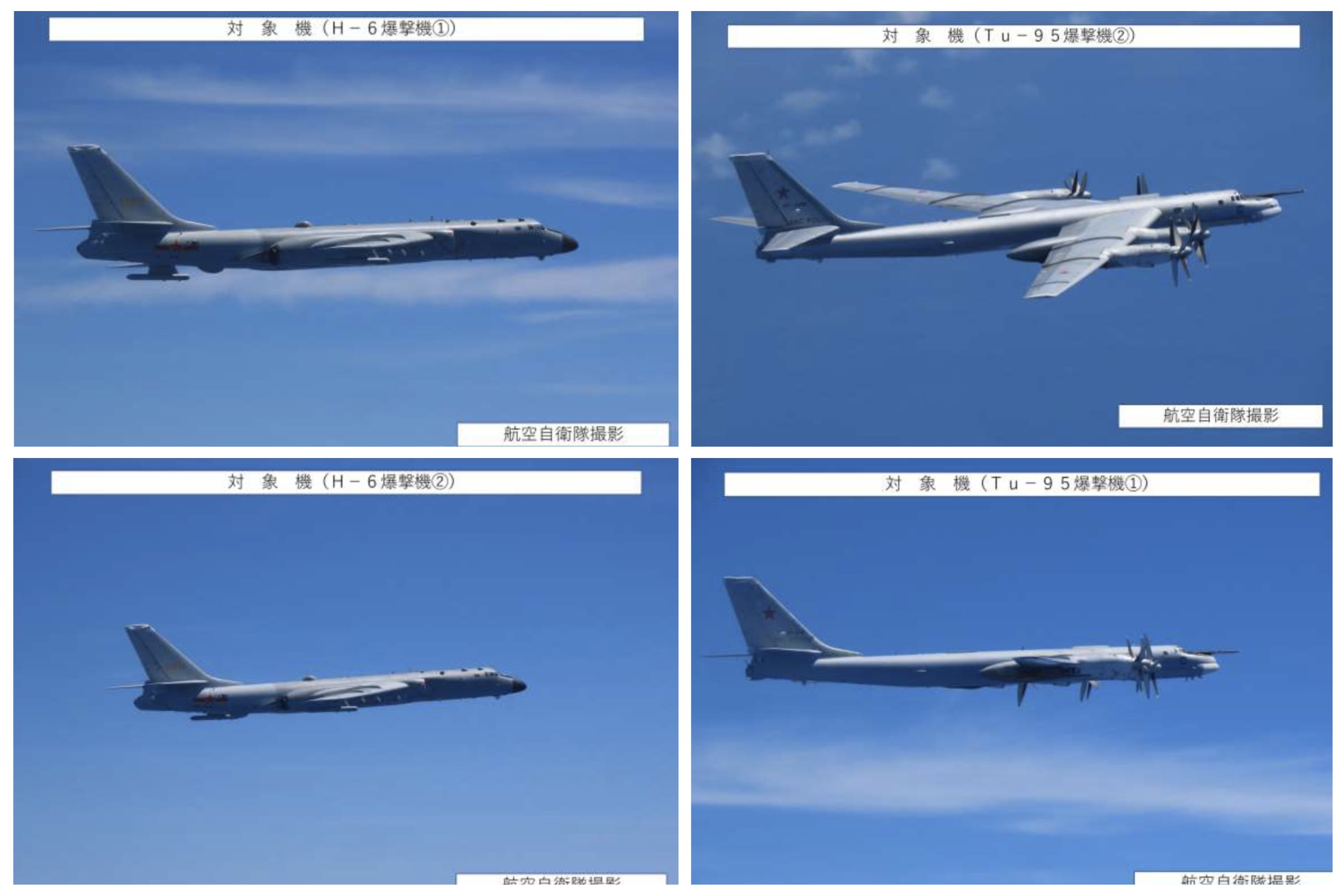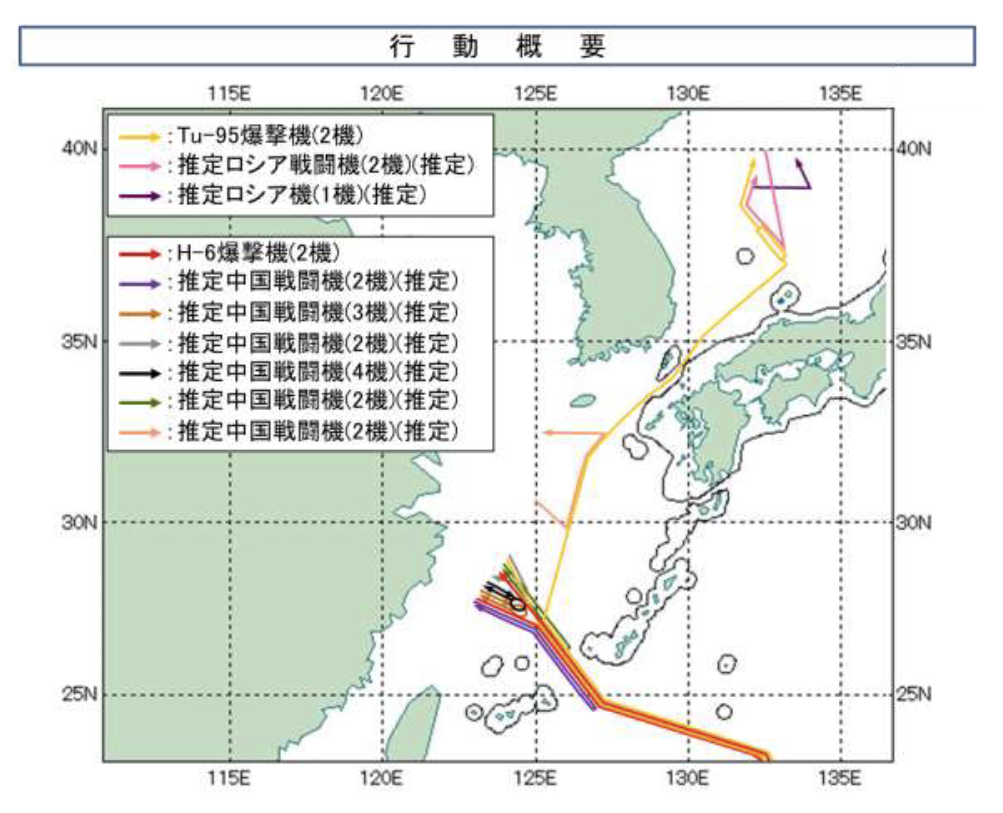
Russian and Chinese bombers continued to fly missions around Japan and South Korea this week after an initial joint bomber mission on Monday, according to the Japanese and Russian defense ministries.
On Wednesday afternoon, two Chinese H-6 bombers and two Russian Tu-95 bombers flew from China and into the Pacific Ocean, according to Japan’s Joint Staff Office of the Ministry of Defense. Prior to flying through the Miyako Strait, four Chinese fighters joined the bombers. On their return through the Miyako Strait, two Chinese fighters joined the formation.
When the two Russian bombers flew to the Tsushima Strait, two aircraft presumed to be Chinese fighters joined them while seven other aircraft, also presumed to be Chinese fighters, were active over the East China Sea.
During the flight over the Sea of Japan to Russia, the two Russian bombers were joined by two presumed Russian fighters, while another Russian aircraft had flown East over the Sea of Japan before turning northwest to the Russian continent. The JSO stated that in response, it scrambled fighters from the Southwestern Air Defense Force of the Japan Air Self-Defense Force (JASDF) and other commands.
Russian’s Ministry of Defense confirmed some details, saying Russia and China flew a joint eight-hour air patrol over the Sea of Japan, the East China Sea and the western part of the Pacific Ocean on Wednesday. Russian Su-30 and SU-35 fighters and Chinese J-11 fighters provided fighter cover along the entire route, according to the release. During the joint air patrol, Russian aircraft landed and took off from an airfield in the People’s Republic of China, the Russian Ministry of Defense said.

China’s Ministry of National Defense issued a short one-line release on Wednesday that read: “On June 7, the Chinese and Russian militaries completed the second phase of the sixth joint air strategic cruise in the western Pacific airspace.”
Japanese officials have spoken out against the flights, with Japanese Chief Cabinet Secretary Hirokazu Matsuno telling a media conference on Wednesday that the flights, while not violating Japanese airspace, were a grave security concern for Japan as they appeared to be directed towards Japan. Tokyo lodged its concern via diplomatic channels.
“Such repeated joint flights by the strategic bombers of the two countries in the vicinity of our country signify the expansion of activities in the vicinity of our country, and are clearly intended to act arbitrarily against our country,” Matsuno said. On Thursday, Matsuno told a media conference that Japan had lodged a protest to China after a People’s Liberation Army Navy survey vessel entered Japan’s waters near Yakushima Island that day.
On the same day, the JSO issued a news release stating that at around 7:30 a.m. local time, PLAN Shupang-class survey ship Qian Sanqiang (22) was sighted sailing westward through Japan’s contiguous zone southeast of Yakushima Island. At around 10:00 a.m, the survey ship entered Japanese territorial waters southwest of Yakushima Island. At 1 p.m, the PLAN ship left Japan’s territorial waters west of Kuchinoerabu Island and sailed west, according to the release. Japan Maritime Self-Defense Force destroyer escort JS Tone (DE-234) and a JMSDF P-1 Maritime Patrol Aircraft (MPA) of Fleet Air Wing 1 based at JMSDF Kanoya Air Base, Kyushu surveilled the PLAN ship.
On Thursday, PLAN destroyer CNS Xiamen (154) and frigate CNS Yangzhou (578) were sighted sailing northwest in an area about 70 miles northeast of the island of Amami Oshima, located in southwest Japan, and subsequently sailed southwest to enter the East China Sea, according to a statement from the Japanese Self-Defense Forces. The statement said the two PLAN ships transited southeast through the Miyako Strait on Tuesday. A JMSDF P-1 MPA of Fleet Air Wing 1 shadowed the PLAN ships. Japan’s straits are mostly designated as international waterways, so foreign ships and aircraft have unrestricted access for transit.
Meanwhile, the Japanese Defense Ministry announced on Friday that in early June, Royal Canadian Navy frigate (RCN) HMCS Montreal (FFH336) carried out monitoring and surveillance activities in the waters surrounding Japan, including the East China Sea, for illicit maritime activities like ship-to-ship transfers with North Korean-flagged vessels prohibited by the United Nations Security Council resolutions. This is the seventh time the RCN has carried out this operation, the release noted. RCN ships and Royal Canadian Air Force (RCAF) CP-140 Aurora MPAs routinely deploy under Operation Neon, which is Canada’s support for the multinational effort to conduct surveillance in support of U.N. sanctions on North Korea.
In the past 12 months though, Canada has reported that its surveillance flights have been subjected to unsafe interceptions by Chinese fighter aircraft on several occasions.





